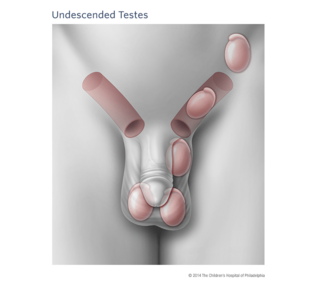What is an undescended testicle?
As the male fetus grows, the testicles develop near the kidneys. The testicles travel down into the scrotum between 28 and 40 weeks gestation. At birth, 2 to 3 percent of boys will have one testicle that is not in the scrotum. The final descent of the testis may take up to six months after birth, but usually occurs within three months of birth.

If a testicle has not reached the scrotum by the time the baby is 6 months of age, it is considered an undescended testicle. This can occur to one or both testicles.
Signs and symptoms
Boys generally do not have symptoms associated with an undescended testicle. It is discovered during a physical exam. On exam, the undescended testicle may be felt anywhere along the path that the testicle takes as it descends.
Risks
- Future fertility: It is important to preserve the sperm in the undescended testicle. Surgically bringing the testicle into the scrotum can increase future fertility potential.
- Risk of testicular cancer: Although rare, boys who have an undescended testicle are at a slightly higher risk of developing a testicular cancer. If a testicle is left in a position where it cannot be felt, a monthly self-testicular examination to assess for changes in the testicle cannot be done. Bringing the testicle into the scrotal position will allow teenage boys and men to perform monthly self-testicular exams that may help identify a tumor in the rare event that one occurs.
- Higher risk for testicular torsion: Testicular torsion occurs when the testicle twists on its own blood supply. It is a very painful experience and requires immediate medical attention.
Treatment
If the testicle is not felt in the scrotum by 6 months of age, or if the testis is very high at 3 months of age, our team in the Division of Urology will recommend surgery. The surgical procedure to bring the testicle down into the scrotum is called an orchiopexy (also known as orchidopexy).
We perform these surgeries in the operating room. Generally a small incision is made in the groin and in the scrotum. The testicle is pulled down and placed in a small pouch in the scrotum and attached with stitches. Your child should be able to go home the same day.
Each year, our physicians perform nearly 600 orchiopexies. It is one of the more common surgeries we do in our Division.
Learn more about surgery for undescended testicles.
Research
Research regarding undescended testicles is ongoing at the Children’s Hospital. We have a clinical database of patients who have undergone surgery.
Our current projects are looking for associations between information we obtained at the time of the child’s surgery (e.g., the location of the testes at birth and the number and type of cells present in the testis) with semen analysis, testis ultrasound and hormonal data we obtained once the patients turned 18.
Molecular research is aimed at identifying the genes associated with the causes of an undescended testicle and the long-term possibility of infertility in boys born with undescended testes.
Reviewed by: Division of Urology
Date: May 2011
Resources to help
Division of Urology Resources
Caring for a child with an illness or injury can be overwhelming. We have resources to help you find answers to your questions and feel confident in the care you are providing your child.
